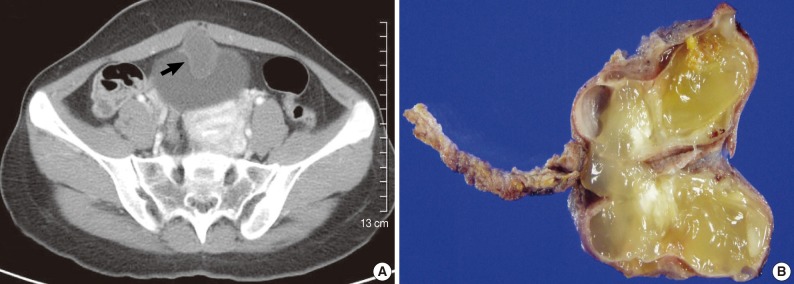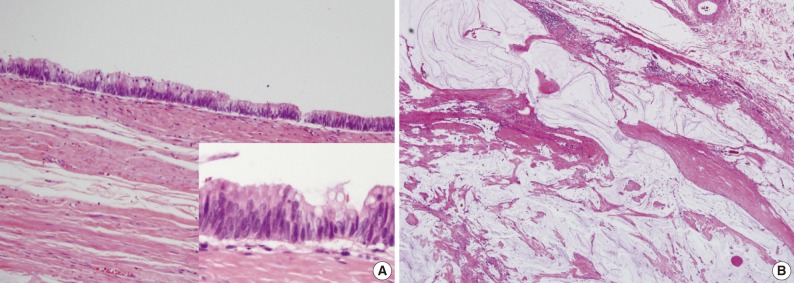Articles
- Page Path
- HOME > J Pathol Transl Med > Volume 46(1); 2012 > Article
-
Case Report
Urachal Mucinous Tumor of Uncertain Malignant Potential: A Case Report - Jung-Woo Choi, Ju-Han Lee, Young-Sik Kim
-
Korean Journal of Pathology 2012;46(1):83-86.
DOI: https://doi.org/10.4132/KoreanJPathol.2012.46.1.83
Published online: February 23, 2012
Department of Pathology, Korea University Ansan Hospital, Korea University College of Medicine, Ansan, Korea.
- Corresponding Author: Young-Sik Kim, M.D. Department of Pathology, Korea University Ansan Hospital, Korea University College of Medicine, 516 Gojan 1-dong, Danwon-gu, Ansan 425-707, Korea. Tel: +82-31-412-5322, Fax: +82-31-412-5324, 'apysk@korea.ac.kr'
• Received: December 6, 2010 • Revised: February 11, 2011 • Accepted: February 22, 2011
© 2012 The Korean Society of Pathologists/The Korean Society for Cytopathology
This is an Open Access article distributed under the terms of the Creative Commons Attribution Non-Commercial License (http://creativecommons.org/licenses/by-nc/3.0) which permits unrestricted non-commercial use, distribution, and reproduction in any medium, provided the original work is properly cited.
Figure & Data
References
Citations
Citations to this article as recorded by 

- Mucinous Cystadenoma of the Urachus and Review of Current Classification of Urachal Mucinous Cystic Neoplasms
Diping Wang, Norbert Sule
Archives of Pathology & Laboratory Medicine.2019; 143(2): 258. CrossRef - Urachal Mucinous Cystic Tumor of Low Malignant Potential with Concurrent Sigmoid Colon Adenocarcinoma
Kelly Brennan, Paul Johnson, Heather Curtis, Thomas Arnason
Case Reports in Gastrointestinal Medicine.2019; 2019: 1. CrossRef - Pseudomyxoma Peritonei Arising from Mucinous Cystadenoma of the Urachus with Postoperative Disease-Free Survival over 15 Years
Tomoki Kobayashi, Shinichi Mizuno, Hideki Matsuba, Min Kanamori, Toshio Tamauchi, Makoto Urano
The Japanese Journal of Gastroenterological Surgery.2019; 52(6): 307. CrossRef - Urachal borderline mucinous cystadenoma
Jingjun Wu, Ailian Liu, Anliang Chen, Pengxin Zhang
Medicine.2017; 96(47): e8740. CrossRef - Incidental Finding of a Rare Urachal Pathology: Urachal Mucinous Cystic Tumour of Low Malignant Potential
Luke L. Wang, Heath Liddell, Sharman Tan Tanny, Briony Norris, Sree Appu, David Pan
Case Reports in Urology.2016; 2016: 1. CrossRef - A Case of Borderline Mucinous Cystadenoma Thought to be of Urachal Origin
Kiichiro YAGUCHI, Yoshihito GOMYO, Hiroyasu SAITO, Tatsuo IKENO, Hiromi SAKAGUCHI, Hideo MIYAMOTO
Nihon Rinsho Geka Gakkai Zasshi (Journal of Japan Surgical Association).2014; 75(5): 1418. CrossRef - An unexpected mass of the urachus: a case report
Monica C. Pasternak, Jonathan D. Black, Natalia Buza, Masoud Azodi, Aileen Gariepy
American Journal of Obstetrics and Gynecology.2014; 211(4): e1. CrossRef
Urachal Mucinous Tumor of Uncertain Malignant Potential: A Case Report


Fig. 1 (A) Computed tomography scan of the pelvis reveals an irregular cystic mass (arrow) in the dome of the urinary bladder. (B) Grossly, the multilocular cyst contains abundant mucin.
Fig. 2 (A) Microscopically, the lining epithelium consists of stratified atypical columnar cells containing mucin. (B) The underlying stroma shows extensive mucin extravasations without tumor cells.
Fig. 1
Fig. 2
Urachal Mucinous Tumor of Uncertain Malignant Potential: A Case Report

Table 1 Reported cases of urachal mucinous tumors with uncertain malignant potential
PMP, pseudomyxoma peritonei; WOR, without recurrence.

 E-submission
E-submission



 PubReader
PubReader Cite this Article
Cite this Article



